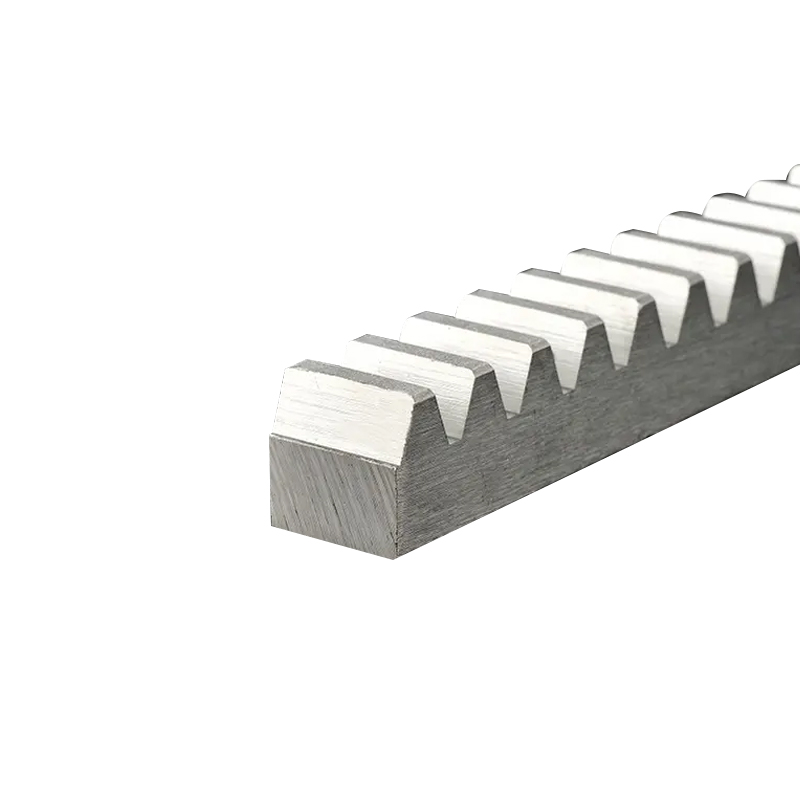No. 200 Gaoxin RD, Shanghua St, Lanxi, Zhejiang, P. R China
The Stainless Steel Stepped Rack Pinion Gear is a highly versatile and...
See DetailsThe racks are also divided into straight racks and helical racks, which are paired with spur gears and helical gears respectively;

The tooth profile of the rack is a straight line instead of an involute (for the tooth surface, it is a flat surface), which is equivalent to an infinite cylindrical gear with a pitch circle radius.
The main features of the rack
(1) Since the rack tooth profile is a straight line, each point on the tooth profile has the same pressure angle and is equal to the inclination angle of the tooth profile. This angle is called the tooth profile angle and the standard value is 20°.
(2) Any straight line parallel to the tooth top line has the same pitch and modulus.
(3) The straight line parallel to the tooth top line and the tooth thickness equal to the tooth slot width is called the index line (center line), which is the reference line for calculating the rack size.
The main parameters of the rack
Tooth width, tooth tip height, tooth root height, tooth height, tooth thickness, tooth root radius, etc.
Nylon rack and pinion systems are widely used in applications where quiet operation, low weight, and corrosion resistance are priorities. The rack, made from reinforced nylon, works in conjunction with a pinion—usually metallic—to convert rotational motion into straight-line movement. One of the primary advantages of nylon gear racks is their ability to operate with significantly less noise compared to metal alternatives. This is especially beneficial in environments like office buildings, residential gates, or light industrial settings where noise control is important.
In addition to noise reduction, nylon racks are non-conductive and resistant to many chemicals, making them suitable for use in environments that require electrical insulation or are exposed to corrosive substances. Nylon's natural self-lubricating properties also contribute to smoother motion and reduced maintenance demands.
However, nylon racks do have certain limitations. They are typically not suitable for applications involving very high loads or continuous high-temperature environments. Reinforced versions, often combined with steel inserts, are used to extend load-bearing capabilities and dimensional stability. Even so, compared to fully metallic racks, they may experience more wear under prolonged or intensive use.
Nylon rack and pinion systems are better suited for light to moderate-duty operations where smooth, quiet motion and resistance to environmental factors are desired. Their ease of installation and cost-effectiveness further enhance their appeal in commercial automation and access control systems.
The Role of Modern Alloy Straight Gear Rack
Modern alloy straight gear racks are designed for performance in demanding mechanical and industrial systems. Typically constructed from hardened steel alloys, these gear racks offer high strength, precise movement, and resistance to wear and deformation. Their straight-cut teeth allow for smooth engagement with a matching spur gear, translating rotary motion into accurate linear travel.
One of the key roles of alloy gear racks is in high-load and high-duty-cycle environments. Industrial automation systems, heavy gates, machine tools, and CNC machinery often rely on alloy racks due to their reliability and ability to withstand significant operational stress. Heat treatment and surface hardening processes are frequently applied during manufacturing to increase durability and reduce wear over time.
The dimensional accuracy of alloy gear racks makes them ideal for applications where precision is essential. In machine positioning systems, for example, even minor deviations can impact performance. Alloy gear racks maintain their shape and alignment under mechanical stress, enabling repeatable, consistent motion. They are also compatible with a wide range of spur gears and can be mounted securely to supporting structures.
Another important role is their adaptability to different operational conditions. Unlike plastic or composite racks, alloy racks are unaffected by ultraviolet radiation, temperature, or chemical exposure in industrial contexts. With proper lubrication and maintenance, they offer long service life and reduced downtime, which is essential in production environments.
Modern alloy straight gear racks provide dependable motion control in high-performance systems. Their structural integrity, resistance to wear, and precision make them a critical component in industrial automation, robotics, and gate automation, where consistent functionality and load endurance are vital.
Together, nylon and alloy gear racks offer a range of mechanical solutions tailored to specific operational needs—balancing factors like load capacity, environmental conditions, noise level, and cost-efficiency.